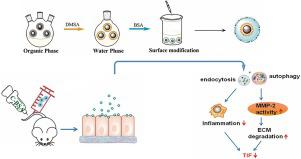Colloids and Surfaces B: Biointerfaces ( IF 5.8 ) Pub Date : 2020-11-15 , DOI: 10.1016/j.colsurfb.2020.111470 Lei Liu 1 , Qing Xu 2 , Lei Zhang 3 , Hui Sun 4 , Fengan Ding 5 , Yiping Li 5 , Pingsheng Chen 5

|
Albuminuria is a primary feature in patients with CKD and an important contributor to tubulointerstitial fibrosis (TIF) development. Autophagy has been considered to be involved in renal tubular injury caused by albuminuria. Fe3O4 magnetic nanoparticles are related to many cellular activities, such as autophagy and inflammation. Rab7, a molecule involved in both endocytosis and autophagy, has been identified to protect renal tubular epithelial cells from albumin by regulating autophagy and MMP-2 activity in the early stage of albumin stimulation, but its role in the advanced stage is still unclear. Therefore, to investigate the effect of Fe3O4 magnetic nanoparticles on chronic renal tubular injury induced by excess albumin and to further determine the specific role of Rab7, we established a mouse model of TIF by intravenous injection of cationic bovine serum albumin (C-BSA) in Rab7-overexpressing transgenic mice. Our data revealed the decreased autophagy level, weakened MMP-2 activity and exacerbated renal tubular injury in these BSA-overloaded mice; furthermore, the degree of injury was more serious in Rab7-overexpressing transgenic mice. However, the application of Fe3O4 magnetic albumin nanoparticles (Fe3O4@BSA) enhanced MMP-2 activity and alleviated renal tubular injury, and these changes were mediated by an autophagy-dependent mechanism. Taken together, our results indicated that long-term albumin stimulation combined with overexpression of Rab7 could further decrease MMP-2 activity, exacerbate renal tubular injury and accelerate the development of TIF. Fe3O4@BSA could be a promising targeted tool for the management of CKD patients.
中文翻译:

Fe 3 O 4磁性纳米颗粒通过与Rab7相关的自噬改善白蛋白诱导的肾小管间质纤维化
蛋白尿是CKD患者的主要特征,也是肾小管间质纤维化(TIF)发展的重要因素。自噬被认为与白蛋白尿引起的肾小管损伤有关。Fe 3 O 4磁性纳米颗粒与许多细胞活动有关,例如自噬和炎症。Rab7是一种参与内吞和自噬的分子,已被确定可通过在白蛋白刺激的早期阶段调节自噬和MMP-2活性来保护肾小管上皮细胞免受白蛋白的侵害,但其在晚期的作用尚不清楚。因此,要研究Fe 3 O 4的作用磁性纳米颗粒对过量白蛋白引起的慢性肾小管损伤的影响,并进一步确定Rab7的特定作用,我们通过在过表达Rab7的转基因小鼠中静脉注射阳离子牛血清白蛋白(C-BSA)建立了TIF小鼠模型。我们的数据显示,这些BSA超负荷小鼠的自噬水平降低,MMP-2活性减弱并加重了肾小管损伤。此外,在过度表达Rab7的转基因小鼠中损伤程度更为严重。然而,Fe 3 O 4磁性白蛋白纳米颗粒(Fe 3 O 4@BSA)可增强MMP-2活性并减轻肾小管损伤,这些变化是由自噬依赖性机制介导的。两者合计,我们的结果表明,长期的白蛋白刺激与Rab7的过度表达可能进一步降低MMP-2活性,加剧肾小管损伤并加速TIF的发展。Fe 3 O 4 @BSA可能是有前景的针对CKD患者的靶向治疗工具。



























 京公网安备 11010802027423号
京公网安备 11010802027423号